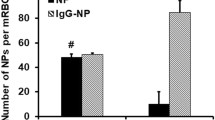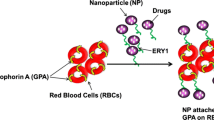Abstract
Nanoparticles (NPs) are drawing an increasing clinical interest because of their potential use as drug carriers. Recently, a new strategy for elevation of NPs in vivo circulation time has been proposed, specifically, utilizing red blood cells (RBCs) as a carrier for NPs, that are loaded with a drug, by interaction (in vitro) of human RBCs with NPs (RBCNP). This class of delivery set-up, combines advantages of natural RBCs and synthetic biomaterials. Previous studies demonstrated that NPs initiated hemolysis of RBC and activated cells aggregation. In the present study, we examined the effect of RBCNP on the aggregation of RBC and their adhesion to endothelial cells (EC). Red cells were treated with polystyrene NPs (PS-NP), and following their washing, were added to suspension of untreated cells at various concentrations. We observed that the PS-NP and RBCNP initiated the formation of red cells aggregates and markedly elevated RBC adhesion to EC. These effects were augmented with (a) increasing concentration of NPs or RBCNP, and (b) with decreasing NP size. This implies that RBCNP are cells with a stronger intercellular interaction, and may thereby induce the formation of large and strong aggregates with untreated RBC, as well as strong RBC/EC interaction.



Similar content being viewed by others
References
Holzinger, M., Le Goff, A., & Cosnier, S. (2014). Nanomaterials for biosensing applications: A review. Frontiers in chemistry, 2, 63.
Rostami, E., Kashanian, S., Azandaryani, A. H., Faramarzi, H., Dolatabadi, J. E., & Omidfar, K. (2014). Drug targeting using solid lipid nanoparticles. Chemistry and Physics of Lipids, 181, 56–61.
Shvartsman, L., & Laikhtman, B. (2010). Medical application-oriented nanostructure design: Physical basics and limitations. SPIE Proceedings, 7563, A1–A10.
Chambers, E., & Mitragotri, S. (2004). Prolonged circulation of large polymeric nanoparticles by non-covalent adsorption on erythrocytes. Journal of Controlled Release, 100, 111–119.
Hu, C. M., Fang, R. H., & Zhan, L. (2013). Erythrocyte-inspired delivery systems. Advanced Healthcare Materials, 1, 537–547.
Gutierrez Millan, C., Colino Gandarillas, C. I., Sayalero Marinero, M. L., & Lanao, J. M. (2012). Cell-based drug-delivery platforms. Therapeutic Delivery, 2012(3), 25–41.
Wang, T., Bai, J., Jiang, X., & Nienhaus, G. U. (2012). Cellular uptake of nanoparticles by membrane penetration: a study combining confocal microscopy with FTIR spectroelectrochemistry. ACS Nano, 6, 1251–1259.
Choi, J., Reipa, V., Hitchins, V. M., Goering, P. L., & Malinauskas, R. A. (2012). Physicochemical characterization and in vitro hemolysis evaluation of silver nanoparticles. Toxicological Sciences, 123, 133–143.
Yu, T., Malugin, A., & Ghandehari, H. (2012). Impact of silica nanoparticle design on cellular toxicity and hemolytic activity. ACS Nano, 5, 5717–5728.
Barshtein, G., Arbell, D., & Yedgar, S. (2011). Hemolytic effect of polymeric nanoparticles: role of albumin. IEEE Transactions on Nanobioscience, 10, 259–261.
Han, Y., Wang, X., Dai, H., & Li, S. (2012). Nanosize and surface charge effects of hydroxyapatite nanoparticles on red blood cell suspensions. ACS Applied Materials & Interfaces, 4, 4616–4622.
Simundic, M., Drasler, B., Sustar, V., Zupanc, J., Stukelj, R., Makovec, D., et al. (2013). Effect of engineered TiO2 and ZnO nanoparticles on erythrocytes, platelet-rich plasma and giant unilamelar phospholipid vesicles. BMC Veterinary Research, 9, 7.
Smyth, E., Solomon, A., Vydyanath, A., Luther, P. K., Pitchford, S., Tetley, T. D., & Emerson, M. (2015). Induction and enhancement of platelet aggregation in vitro and in vivo by model polystyrene nanoparticles. Nanotoxicology, 9, 356–364.
Chambers, E., & Mitragotri, S. (2007). Long circulating nanoparticles via adhesion on red blood cells: mechanism and extended circulation. Experimental Biology and Medicine (Maywood), 232, 958–966.
Zook, J. M., Maccuspie, R. I., Locascio, L. E., Halter, M. D., & Elliott, J. T. (2011). Stable nanoparticle aggregates/agglomerates of different sizes and the effect of their size on hemolytic cytotoxicity. Nanotoxicology, 5, 517–530.
Brown, D. M., Wilson, M. R., MacNee, W., Stone, V., & Donaldson, K. (2001). Size-dependent proinflammatory effects of ultrafine polystyrene particles: a role for surface area and oxidative stress in the enhanced activity of ultrafines. Toxicology and Applied Pharmacology, 175, 191–199.
Geiser, M., Rothen-Rutishauser, B., Kapp, N., Schurch, S., Kreyling, W., Schulz, H., et al. (2005). Ultrafine particles cross cellular membranes by nonphagocytic mechanisms in lungs and in cultured cells. Environmental Health Perspectives, 113, 1555–1560.
Papageorgiou, I., Brown, C., Schins, R., Singh, S., Newson, R., Davis, S., et al. (2007). The effect of nano- and micron-sized particles of cobalt-chromium alloy on human fibroblasts in vitro. Biomaterials, 28, 2946–2958.
Kato, T., Yashiro, T., Murata, Y., Herbert, D. C., Oshikawa, K., Bando, M., et al. (2003). Evidence that exogenous substances can be phagocytized by alveolar epithelial cells and transported into blood capillaries. Cell and Tissue Research, 311, 47–51.
Yacobi, N. R., Demaio, L., Xie, J., Hamm-Alvarez, S. F., Borok, Z., Kim, K. J., & Crandall, E. D. (2008). Polystyrene nanoparticle trafficking across alveolar epithelium. Nanomedicine, 4, 139–145.
McGuinnes, C., Duffin, R., Brown, S., Mill, N., Megson, I. L., Macnee, W., et al. (2011). Surface derivatization state of polystyrene latex nanoparticles determines both their potency and their mechanism of causing human platelet aggregation in vitro. Toxicological Sciences, 119, 359–368.
Mielczarski, J. A., Jeyachandran, Y. L., Mielczarski, E., & Rai, B. (2011). Modification of polystyrene surface in aqueous solutions. Journal of Colloid and Interface Science, 362, 532–539.
Ami, R. B., Barshtein, G., Zeltser, D., Goldberg, Y., Shapira, I., Roth, A., et al. (2001). Parameters of red blood cell aggregation as correlates of the inflammatory state. American Journal of Physiology Heart and Circulatory Physiology, 280, H1982–H1988.
Barshtein, G., Wajnblum, D., & Yedgar, S. (2000). Kinetics of linear rouleaux formation studied by visual monitoring of red cell dynamic organization. Biophysical Journal, 78, 2470–2474.
Ben-Ami, R., Barshtein, G., Mardi, T., Deutch, V., Elkayam, O., Yedgar, S., & Berliner, S. (2003). A synergistic effect of albumin and fibrinogen on immunoglobulin-induced red blood cell aggregation. American Journal of Physiology Heart and Circulatory Physiology, 285, H2663–H2669.
Ben-Ami, R., Sheinman, G., Yedgar, S., Eldor, A., Roth, A., Berliner, A. S., & Barshtein, G. (2002). Thrombolytic therapy reduces red blood cell aggregation in plasma without affecting intrinsic aggregability. Thrombosis Research, 105, 487–492.
Berliner, S., Ben-Ami, R., Samocha-Bonet, D., Abu-Abeid, S., Schechner, V., Beigel, Y., et al. (2004). The degree of red blood cell aggregation on peripheral blood glass slides corresponds to inter-erythrocyte cohesive forces in laminar flow. Thrombosis Research, 114, 37–44.
Chen, S., Gavish, B., Barshtein, G., Mahler, Y., & Yedgar, S. (1994). Red blood cell aggregability is enhanced by physiological levels of hydrostatic pressure. Biochimica et Biophysica Acta, 1192, 247–252.
Chen, S., Eldor, A., Barshtein, G., Zhang, S., Goldfarb, A., Rachmilewitz, E., & Yedgar, S. (1996). Enhanced aggregability of red blood cells of beta-thalassemia major patients. The American Journal of Physiology, 270, H1951–H1956.
Chen, S., Gavish, B., Zhang, S., Mahler, Y., & Yedgar, S. (1995). Monitoring of erythrocyte aggregate morphology under flow by computerized image analysis. Biorheology, 32, 487–496.
Barshtein, G., Ponizovsky, A. M., Nechamkin, Y., Ritsner, M., Yedgar, S., & Bergelson, L. D. (2004). Aggregability of red blood cells of schizophrenia patients with negative syndrome is selectively enhanced. Schizophrenia Bulletin, 30, 913–922.
Ramot, Y., Koshkaryev, A., Goldfarb, A., Yedgar, S., & Barshtein, G. (2008). Phenylhydrazine as a partial model for beta-thalassaemia red blood cell hemodynamic properties. British Journal of Haematology, 140, 692–700.
Koshkaryev, A., Barshtein, G., Nyska, A., Ezov, N., Levin-Harrus, T., Shabat, S., et al. (2003). 2-Butoxyethanol enhances the adherence of red blood cells. Archives of Toxicology, 77, 465–469.
Koshkaryev, A., Barshtein, G., & Yedgar, S. (2010). Vitamin E induces phosphatidylserine externalization and red cell adhesion to endothelial cells. Cell Biochemistry and Biophysics, 56, 109–114.
Barshtein, G., Tamir, I., & Yedgar, S. (1998). Red blood cell rouleaux formation in dextran solution: dependence on polymer conformation. European Biophysics Journal : EBJ., 27, 177–181.
Peetla, C., & Labhasetwar, V. (2008). Biophysical characterization of nanoparticle-endothelial model cell membrane interactions. Molecular Pharmaceutics, 5, 418–429.
Guarnieri, D., Guaccio, A., Fusco, S., & Netti, P. A. (2011). Effect of serum proteins on polystyrene nanoparticle uptake and intracellular trafficking in endothelial cells. Journal of Nanoparticle Research, 13, 4295–4309.
Nel, A., Xia, T., Madler, L., & Li, N. (2006). Toxic potential of materials at the nanolevel. Science, 311, 622–627.
Dash, B. C., Rethore, G., Monaghan, M., Fitzgerald, K., Gallagher, W., & Pandit, A. (2010). The influence of size and charge of chitosan/polyglutamic acid hollow spheres on cellular internalization, viability and blood compatibility. Biomaterials, 31, 8188–8197.
Lin, Y. S., & Haynes, C. L. (2010). Impacts of mesoporous silica nanoparticle size, pore ordering, and pore integrity on hemolytic activity. Journal of the American Chemical Society, 132, 4834–4842.
Dobrovolskaia, M. A., Clogston, J. D., Neun, B. W., Hall, J. B., Patri, A. K., & McNeil, S. E. (2008). Method for analysis of nanoparticle hemolytic properties in vitro. Nano Letters, 8, 2180–2187.
Wang, M. L., Hauschka, P. V., Tuan, R. S., & Steinbeck, M. J. (2002). Exposure to particles stimulates superoxide production by human THP-1 macrophages and avian HD-11EM osteoclasts activated by tumor necrosis factor-alpha and PMA. Journal of Arthroplasty, 17, 335–346.
Blank, F., Rothen-Rutishauser, B., & Gehr, P. (2007). Dendritic cells and macrophages form a transepithelial network against foreign particulate antigens. American Journal of Respiratory Cell and Molecular Biology, 36, 669–677.
Mrakovcic, M., Absenger, M., Riedl, R., Smole, C., Roblegg, E., Frohlich, L. F., & Frohlich, E. (2013). Assessment of long-term effects of nanoparticles in a microcarrier cell culture system. PLoS One, 8, e56791.
Rothen-Rutishauser, B. M., Schurch, S., Haenni, B., Kapp, N., & Gehr, P. (2006). Interaction of fine particles and nanoparticles with red blood cells visualized with advanced microscopic techniques. Environmental Science and Technology, 40, 4353–4359.
Jiang, X. E., Dausend, J., Hafner, M., Musyanovych, A., Rocker, C., Landfester, K., et al. (2010). Specific effects of surface amines on polystyrene nanoparticles in their interactions with mesenchymal stem cells. Biomacromolecules, 11, 748–753.
Yacobi, N. R., Malmstadt, N., Fazlollahi, F., DeMaio, L., Marchelletta, R., Hamm-Alvarez, S. F., et al. (2010). Mechanisms of alveolar epithelial translocation of a defined population of nanoparticles. American Journal of Respiratory Cell and Molecular Biology, 42, 604–614.
Yoon, J. Y., Kim, J. H., & Kim, W. S. (1998). Interpretation of protein adsorption phenomena onto functional microspheres. Colloid Surface B, 12, 15–22.
Yoon, J. Y., Park, H. Y., Kim, J. H., & Kim, W. S. (1996). Adsorption of BSA on highly carboxylated microspheres—Quantitative effects of surface functional groups and interaction forces. Journal of Colloid and Interface Science, 177, 613–620.
Anselmo, A. C., Gupta, V., Zern, B. J., Pan, D., Zakrewsky, M., Muzykantov, V., & Mitragotri, S. (2013). Delivering Nanoparticles to Lungs while Avoiding Liver and Spleen through Adsorption on Red Blood Cells. ACS Nano, 7, 11129–11137.
Chien, S., & Jan, K. (1973). Ultrastructural basis of the mechanism of rouleaux formation. Microvascular Research, 5, 155–166.
Barshtein, G., Ben-Ami, R., & Yedgar, S. (2007). Role of red blood cell flow behavior in hemodynamics and hemostasis. Expert Review of Cardiovascular Therapy, 5, 743–752.
Ihler, G. M., Glew, R. H., & Schnure, F. W. (1973). Enzyme loading of erythrocytes. Proceedings of the National Academy of Sciences, 70, 2663–2666.
Casals, E., Pfaller, T., Duschl, A., Oostingh, G. J., & Puntes, V. (2010). Time evolution of the nanoparticle protein corona. ACS Nano, 4, 3623–3632.
Cedervall, T., Lynch, I., Lindman, S., Berggard, T., Thulin, E., Nilsson, H., et al. (2007). Understanding the nanoparticle-protein corona using methods to quantify exchange rates and affinities of proteins for nanoparticles. Proceedings of the National Academy of Sciences, 104, 2050–2055.
Treuel, L., Docter, D., Maskos, M., & Stauber, R. H. (2015). Protein corona—from molecular adsorption to physiological complexity. Beilstein Journal of Nanotechnology, 6, 857–873.
Acknowledgments
The authors thank Mrs. O. Fredman for technical assistance.
Author information
Authors and Affiliations
Corresponding author
Rights and permissions
About this article
Cite this article
Barshtein, G., Livshits, L., Shvartsman, L.D. et al. Polystyrene Nanoparticles Activate Erythrocyte Aggregation and Adhesion to Endothelial Cells. Cell Biochem Biophys 74, 19–27 (2016). https://doi.org/10.1007/s12013-015-0705-6
Published:
Issue Date:
DOI: https://doi.org/10.1007/s12013-015-0705-6




